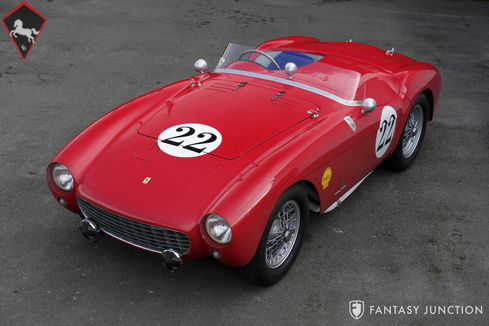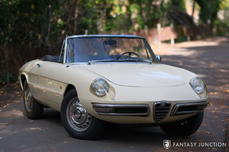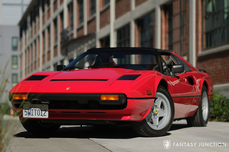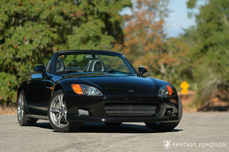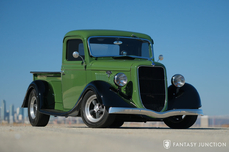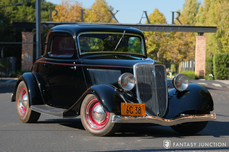Ferrari 500 Mondial 2L Inline DOHC 4 Cylinder (Hall & Hall 3L fitted) 1954
General description :
1954 Ferrari Mondial Pinin Farina Spider
s/n 0408MD, engine. no. 0408MD (internal no. 5MD)
Pinin Farina Body # 12576
Red with Blue Cloth Interior
Automotive historians and enthusiasts alike will most often reference the Ferrari V12 engine and how it propelled this early race car constructor to the celebrated victories that built their reputation. But in the early 1950s Enzo Ferrari began taking notice of smaller, lightweight cars that benefited from four-cylinder engines. These compact engines made great power and were highly competitive even against larger, heavier competitors. Inspired by this, Enzo assigned engineer Aurelio Lampredi to develop a robust, high revving engine leveraging all the traits of the bigger V12, utilizing a compact in-line four-cylinder configuration. The end result would prove to be one of the most successful engine designs, delivering victories in race after race with notable drivers at the wheel including Alberto Ascari who proved the four-cylinder Ferrari was a true contender, achieving consecutive championships in the four-cylinder F2 Monoposto, clinching the 1952 and 1953 title.Engineered with many of the celebrated features of the V12, the 1,984-cc dual overhead-camshaft Lampredi engine featured twin Weber 42/DCO/3 carburetors paired with a four-speed manual transaxle. The surprising 170hp output was certainly robust, but it was the power to weight ratio that not only proved to be fantastic, in some cases, the performance could outdo the V12. Mounted into the tubular steel chassis, the independent front suspension with transverse leaf springs, de Dion rear axle with parallel trailing arms and semi-elliptic leaf springs, with four-wheel drum brakes, all contributed to making a taut and agile race car that operated at peak torque even at lower rpms. The combined package was not only nimble, but the engine also delivered great acceleration especially on tight racecourses and hill climbs where the power to weight advantage and snappy torque proved over and over, Ferrari had once again built a champion.By 1954, Ferrari offered the four-cylinder sports/racer to customers as a two-liter model, with each cylinder displacing almost 500 cubic centimeters. The car was dubbed the 500 Mondial, in recognition of Ascari’s back-to-back World Championships. Beginning with chassis 0404MD, 18 spiders and two berlinettas were built comprising the first series, all of which were bodied by Pinin Farina. A second series of 10 Scaglietti-bodied cars followed, resulting in the construction of just 30 500 Mondials before yielding to the three-liter 750 Monza. Rare in both number and sequence, each of the coveted Mondial cars offer a unique perspective on the period, the engineering of the era, and the racing history that defines each individually realized provenance.
According to the Marcel Massini report and accompanying support documentation specifically referencing the history of chassis #0408, on March 23, 1954, the tipo 501 chassis was completed and the engine and gearbox subsequently prepared in April. The first documented owner of the car was then assigned to Scuderia Ferrari, effectively making its first outing as a Ferrari factory race car. The third of only 22 Series 1 Mondial Spiders constructed, and the third of only 16 bodied by Pinin Farina, the car was fitted with body #12576 by Pinin Farina and dispatched to the 1954 Mille Miglia. With the intention of dominating this event, Ferrari entered an astonishing 24 cars, five of which were Mondials, four being Pinin Farina bodied. The Massini report and supporting letter concludes that through the process of elimination, chassis #0408 was most likely driven by Paolo Pineschi and Mirko Landini in the 1954 Mille Miglia. As was common for the times, the financially challenged Ferrari sold many of their race cars to raise funds to finance the construction of the next models. In May 1954, the car was sold by the Ferrari factory to Swedish importer Tore Bjurstrom, who in turn sold the car shortly thereafter to the first private owner, Valdemar Stener, a resident of Lhusdal, Farila, Sweden. Stener, no stranger to performance cars and a capable racer in his own right, also owned and raced a Ferrari 375MM.
On May 9, 1954, Stener enters the car in the Helsinki Grand Prix, Finland, race #2 where he places 5th in category C for all racing cars, further at Ljungsdalbacken finishing 2nd overall, and then May 23, 1954 at Hedemora, Sweden, placing 2nd overall and 1st in class, race #23. Stener continued to race the car successfully throughout the 1955 racing season, then selling it in October 1955 to Bjorn Martensson. Martensson registered the car on Swedish plates and competed in three ice races with additional recorded races including entry in the 1956 Copenhagen Grand Prix, Denmark, and once again in the 1956 Swedish Grand Prix finishing 2nd in class and 10th overall. In 1957 the car returned to the Ferrari factory where it was overhauled, returning once again to Sweden where it competed in the 1957 Swedish Grand Prix. Later that year the car was sold to Olof “Mas-Olle” Persson, who then won the National Ice Racing Championship driving this car.
In 1958, the car was sold to Lars Edin, Uppsala, Sweden. Edin raced the car a few times before dismantling the original bodywork and commissioning Ockelbo, manufacturers of snowmobiles, to rebody the car with a GRP fiberglass body in the style of Ulf Norinder’s Ferrari 500 Mondial #0580. Using #0580 as a body template, the mold was cast, a body shell made, and the finished car was painted bright yellow with a broad central black stripe covering the entire length of the car longitudinally. Through the 1960s and 1970s the car appeared in this livery in a range of events as Massini documents the changes in ownership until 1973 when it is sold to Gary D. Schmidt. In 1977, Schmidt drives the car in the Mille Miglia Retrospective and other events until selling the car through Italian dealer Corrado Cupellini to Stefano Arborini, a resident of Ferrara, Italy. Under the care of Arborini, the car participated at the Mille Miglia nearly every year of his ownership until sold in 1986 through Dutch dealer Rudy Pas to Adrien De Ghellinck, Brussels, Belgium. De Ghellinck then participates in two Mille Miglia events before selling the car in 1988 to Italian Alessandro Tonolli who further continues the tradition with his participation in the 1989 and 1991 Mille Miglia spending considerable resources on mechanical work on the car performed by Livo Guarnieri between 1993-1995.In 1995, Tonolli delivers the car to Carrozzeria Bachelli & Villa, Bastiglia, Modena where it is rebodied back to the original Pinin Farina Spider configuration using hand-formed alloy panels just as had been done for the original body. Further mechanical sorting was then performed by Livo Guarnieri and completed in time to participate in the 1995 Louis Vuitton Italia Classica held in Italy. In 1997 the car was sold to renowned collector Bruce McCaw, Washington, USA via Brooks Europe Auction. McCaw participated in the 1997 Chrysler Classic Speed Festival, San Diego, CA and in 1999 commissioned a ground-up restoration. After the restoration, McCaw continued to race and show the car in various events including the 2004 Rolex Monterey Historic Automobile Races at Laguna Seca, CA. In 2005, the car was sold to the current owner who, over the past fifteen years has participated in numerous vintage HMSA and CSRG events. Among the more recent achievements, the car finished 1st in class and 2nd at the West Coast 2009 Ferrari Shell Historic Challenge two-day event. The vintage racing logbook included with the car includes the first entry in 1997, multiple Monterey Reunion and Sonoma Historic events in which it won, CSRG David Love Memorial, and concludes with the 2019 Sonoma Festival of Speed in which it won. 2016 Laguna Seca Rolex Monterey Pre-Reunion race results include a 3rd position in Group 1 1947-1955 Sports Racing and GT Cars, 4th position finish in Groupe 1B 1947-1955 Sports Racing and GT Cars, and a 2015 Sonoma Historics 4th position in the Group 2 1946-1955 Sports Racing and Production Cars class.In 2019, under current ownership the original engine no. 0408MD, internal number 5MD was removed and Hall & Hall were contracted to produce a modern-cast 3 Liter engine (stamped to reflect the original chassis and engine number 0408) which was documented with detailed specifications and dyno tested with specialists ‘Auto Restorations’ in New Zealand, returning 200hp at 4,700 rpm (dyno sheet included in documentation). Additionally, Auto Restorations constructed a hand-made de Dion tube to exact specifications, replacing the original unit so as to preserve it without risk of damage while participating in vintage events. To ensure originality of the package, the original de Dion tube was set aside and a newly-fabricated one installed for event purposes. Further work included a new set of custom-made gears installed in the rebuilt transaxle, and a removable roll bar. Most critically, the impossibly rare original matching numbers engine, rebuilt by West Coast Ferrari guru and Pebble Beach winning Patrick Ottis still remains with the car and is thoughtfully included. Engine dyno results for this engine, recorded in 2008, are also included with the car.As many vehicles of this stature will have both historic provenance and hold an important position in motorsports history, there is yet another critical distinction among Ferrari enthusiasts who wish to drive their cars in tours, events, or vintage racing - mechanical confidence. Not simply in restoration, rather at a level where engineering and premier thinking merge with the appropriate application of modern technology while still honoring authentic features original to the car. Here too this particular example is among the most refined and developed by virtue of the extensive and pre-eminently qualified attention that has been so diligently applied from the very best in the industry. The invoice history notebook housing over 300 individual pages from experts including Patrick Ottis, Auto Restorations, Peterson Motorsports, Piece Manifolds, Hall & Hall engineering, Precision Wire Wheels, and numerous other specialty vendors is a fitting document outlining not only the detailed restoration work performed on the car, but also the considerable knowledge and engineering given to refining this Mondial to a level that can be driven with the utmost confidence.Of critical importance, the Hall & Hall 3 liter engine is a superb and powerful modern-built yet period correct engine that affords the preservation of the original matching numbers engine while allowing this Ferrari to serve the dynamic competition purpose, for which it was so brilliantly conceived. The detailed invoice outlining the specifications for the engine demonstrate the superlative engineering and construction that accompany this car from ignition through each consecutive lap. Documentation in each of the invoices is specific to outline details including mag testing for specific parts, dyno testing for the H&H engine, and ongoing inspections and continued attention to detail through 2020 which includes new axles, rear end hubs, rear backing plates for rear brakes, proper fabrication of new internal deDion components, bearing housings, welding and assembly for the deDion tube, and crack testing. Certainly, the financial investment is substantial, but it is also the carefully curated components, the cadre of experts, and the unceasing dedication of the owner to work year after year beautifully composing this significant Mondial into a confident participant of any contemporary event. Invoices dating back to 2005 demonstrate year after year of consistent and dedicated care. Today this Mondial 500 presents in superb visual and mechanical condition with beautiful paint and hand-crafted details that reflect not only a refined and accurate restoration but correct body lines and contours that embody the excellence and raw performance power imbued in the Pinin Farina aesthetic. Every aspect of the exterior finish and detailing are exemplary. True to the Pinin Farina corsa construction the body work displays the distinct rivet pattern at various points on the alloy panels echoing the relationship between race cars of this era and airplane construction. Inescapably beautiful, the front fender lines arche up over the front wheels and drop dramatically at the covered headlights with the wide grille ready to attack anything that dares to challenge the head of the pack. Among the more enticing exterior details, the rear fuel filler cap and carefully scripted Ferrari 500 Mondial lettering put a beautiful finishing competition touch on the muscular flanks. The slightly raised trunk line conceals the required spare tire, rising up to meet the peaked crowns of the rear fender haunches. Even the characteristic belt line recess is beautifully sculpted, sliced into the smooth upper body line giving the car a forward surge of energy. The panel fit is excellent for all openings with precise perimeter finishes along the alloy folds and correct treatment for the inside panels. The reflection lines drape the car in a liquid energy tracing the historic perimeter without interruption. The low windscreen and Borrani wire wheels further give the car an unmistakable stance and powerful presence. With the alloy tonneau in place and the wood rimmed steering wheel crowning above the cowl line, everything about this legendary Ferrari speaks volumes to those who revere the Golden Age of motorsports.Inside the cockpit, the purposefully lightened interior is enhanced with cloth covered seats finished in traditional blue pleated fabric which offers more grip than traditional slick leather. The seat cushions are tucked into the contoured aluminum seat shells. The interior features a metal and aluminum inner structure which has been finished in the typical grey material, showing areas of use typical for cars that have been driven with competition in mind. The instruments are beautifully finished with excellent color, clarity, and detail while the steering wheel boasts the finishes and features that speak volumes of the hands that gripped in anticipation witnessing decades of exiting apexes, one hand on the gearshift, the other unspooling the exit energy as the car bounds into the next straightaway.With the leather bonnet straps unlatched, chrome clasps rotated, the lightweight alloy hood is easily removed, revealing the beautifully cast and finished Hall & Hall 3 liter engine. A work of impeccable quality and superb engineering, this engine not only delivers an amazing level of performance and durability, the aesthetics and casting elegance are every bit as compelling as the original engine upon which the construction was based on. Breathing through eager 58DCOE3 Twin Weber carburetors via short, polished trumpet intakes, the details are brilliantly executed, and the finishes are both authentic and refined. The tuned exhaust funnels down to exit the car just as originally configured, draping through the inner fender and exiting to twin exhaust pipes, collecting under the passenger side with menacing authority.Inside the trunk reveals the fuel tank also constructed with exposed rivets, and mechanical details of historic delight in the original rear suspension, transaxle, and supporting framework. The underside of the car presents honestly with correct period construction for the main tubes and supporting structure and correct lightweight, finned cast aluminum brake drums. The rear transaxle is a vision of Italian mechanical artistry with finned cooling channels which are also echoed in the oil pan casting for the engine. Every aspect of this historically important Ferrari is presented with integrity and pride, reflecting decades of period racing and more recent vintage racing events. The car is accompanied by an impossibly rare and original factory issued Ferrari Mondial “Directions For Use and Upkeep” large format manual, complete with specifications, diagrams, and important service details. Also included is the 2017 Marcel Massini report, the signed Massini letter of review confirming his statement regarding participation of this car in the 1954 Mille Miglia, and the Ottis-rebuilt original matching numbers engine stamped 0408MD, mounted on an engine stand. A host of additional assorted spare parts accompanying the car include:- Magnetos and distributors (two freshly rebuilt magnetos)
- A removable rollbar
- Exact replica spare alloy riveted fuel tank
- 2 sets of Borrani wire wheels with Dunlop tires. The original wheels that came with the car and another new set bought from Borrani.
- 3 Additional Borrani spare wire wheels, no tires mounted
- 5 front and rear brake drums (some turned true)
- Complete exhaust header sets for both engines (two parts)
- Original 0408 engine lines and hardware
- Various pistons, rods etc. various used
- Misc. engine parts (some original to the car)
- New and correct Ferrari type fuel line
- Stub axles, one used, one new
- Original Mondial radiator
- 1 box of valve springs, used
- Cooling system pipe, used
- Drive line yolks, used
- Box of used hardware
- 2 spare U-joints, used
- Distributor cap, used
- Axle shafts, used
- Sway bar brackets
- Different size sway bars
- Spark plugs, used
- Generator, used
- Various engine gaskets
- A custom car cover with bagBeautiful and powerful, with a history of worldwide competition beginning with a Factory entry at the 1954 Mille Miglia, the 1955, 1956, and 1957 Swedish Grand Prix, the 1956 Copenhagen Grand Prix, and numerous Mille Miglia Historic events, this Ferrari Mondial 500 Spider is a rare and fitting ambassador with absolute Carte Blanche invitation to any future premier competition or concours event. The third of just sixteen Pinin Farina Mondial Spiders constructed, benefiting from world class cost-no-object mechanical attention, this Ferrari will continue its reign as a show-stopping example of one of the most beautifully composed competition cars ever constructed. Seminal to the rise of Ferrari as the racing icon it has become today, the Mondial 500 will forever hold a unique and important place in the history of exemplary competition sports cars.
https://fantasyjunction.com/inventory/1954-ferrari-500-mondial/overview
1954 Ferrari 500 Mondial 2L Inline DOHC 4 Cylinder (Hall & Hall 3L fitted) is listed sold on ClassicDigest in Emeryville by Fantasy Junction for Not priced.
Car Facts
Car type : Car Make : Ferrari Model : 500 Mondial Model Version : 2L Inline DOHC 4 Cylinder (Hall & Hall 3L fitted) Engine size : 0.0 Model Year : 1954 Location : Emeryville Vehicle Registration : Normal
Sold
Seller Information
Sold
Other cars listed for sale by this dealer
About Ferrari
The first Ferrari road car was the 125 S introduced in 1947 and powered by a 1.5 L V12 engine, right? Well it's not quite that simple, Ferrari did in fact produce e Tipo 815, in 1940. Tipo 815 was designed by ex-Alfa Romeo engineers Alberto Massimino and Vittorio Bellentani and by Enrico Nardi under Enzo's company but legal issues with the former associate Alfa Romeo prevented Ferrari from launching the Ferrari marque at that point.
Enzo did produce a series of fine road cars in the 50's and 60's but they were merely to finance his true passion racing, wheather GT/Sports car or Grand Prix. The 50's saw the birth of Ferrari's most memorable cars, 250 GTB (tour de France) 250 Testa Rossa, 250 GT swb just to name a few.
Under the surface tension was growing though. In November 1961 long-time sales manager Girolamo Gardini made an ultimatum to Enzo: if tensions continued, he would leave the company. As a result, Gardini was ousted, as well as Scuderia Ferrari manager Romolo Tavoni, chief engineer Carlo Chiti, experimental sports car development chief Giotto Bizzarrini, and a number of others who stood by them.
Without Chiti and Bizzarrini the development of what was to become the most quintessential Ferrari and today the world's most expensive car, 250 GTO, was at a pivoting point. 250 GTO project was saved by a young engineer Mauro Forghieri and long-time racing bodyman Sergio Scaglietti who stepped in and took over the program with known results.
In addition to 250 GTO, Ferrari launced such master pieces as 250 LM, 250P, 275 GTB, 365 GTB/4 "Daytona" during the the 60's
By the late 60's Ferrari's prototypes' success came to a sudden halt by a new competitor, GT40. Ford turned to Lola to produce a Ferrari beating long distance racer after Enzo had cut the deal off with Henry Ford II making the latter absolutely boil with fury. The collaboration between Ford and Lola created the mighty Ford GT40 that gave Ferrari some heavy hits in Le Mans 24 to come.
By the end of the 60's FIAT purchased 50% of the company, starting a development that has led to a new mass-produced era of Ferraris.
Whether you are selling or looking for a classic Ferrari www.classicdigest.com is the place to check out.
